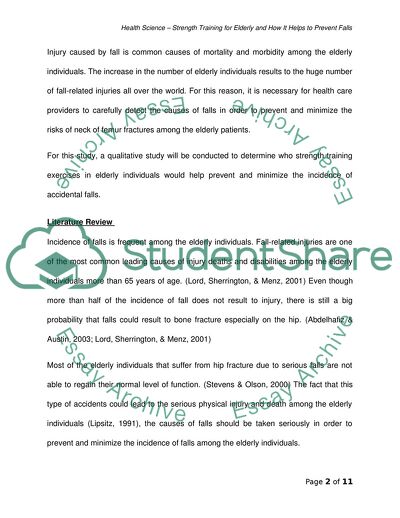
- Home
- Free Samples
- Premium Essays
- Editing Services
- Extra Tools
- Essay Writing Help
- About Us
- Studentshare
- Subjects
- Miscellaneous
- Healh Science- strength training for elderly and how it helps to prevent falls
Healh Science- strength training for elderly and how it helps to prevent falls - Essay Example

- Subject: Miscellaneous
- Type: Essay
- Level: Undergraduate
- Pages: 4 (1000 words)
- Downloads: 0
- Author: gia78
Extract of sample "Healh Science- strength training for elderly and how it helps to prevent falls"
(Lord, Sherrington, & Menz, 2001) Even though more than half of the incidence of fall does not result to injury, there is still a big probability that falls could result to bone fracture especially on the hip. (Abdelhafiz & Austin, 2003; Lord, Sherrington, & Menz, 2001) Most of the elderly individuals that suffer from hip fracture due to serious falls are not able to regain their normal level of function. (Stevens & Olson, 2000) The fact that this type of accidents could lead to the serious physical injury and death among the elderly individuals (Lipsitz, 1991), the causes of falls should be taken seriously in order to prevent and minimize the incidence of falls among the elderly individuals. men. (Lord et al., 1993) This is associated with the higher cases of osteoporosis among older women than in men.
Since the bones of older women with osteoporosis are brittle, they suffer more in terms of having a more serious bone fracture than those without osteoporosis (Lewis, 2002; Ackermann, 1998). Based on a research study, older individuals that had suffered from fall are at a higher risk of falling again (Neyens et al., 2006; Nevitt et al., 1989). Frailer older individuals that are experiencing difficulties in performing the activities of daily living (ADL) are facing higher risks of falling than the vigorous ones.
Northridge et al. (1995) stated that frailer old individuals are most likely to fall twice than the vigorous ones. Speechley & Tinetti (1991) reported the same outcome wherein 52% of the frail group of older individuals fell within a span of one year period as compared to only 17% of the vigorous ones. Particularly the strength of the muscle is one of the most important factors that contribute to human balance capabilities. Impairment of the muscles could highly contribute to the increase in the incidence of falls among the elderly individuals.
In line with this, humans are
...Download file to see next pages Read MoreCHECK THESE SAMPLES OF Healh Science- strength training for elderly and how it helps to prevent falls
Management of risk falls among the elderly
The Disorders of Mobility and Balance in the Hospital Environment
Nutrition in Elderly
Part 1 3000 word lit review part 2 2000 word research proposal
Physical Activity Intervention
The Advantages of Physical Activity for Tai Chi Older Adults and for Elderly Women
Falls Prevention in Health Care Institutions
Risks in the Elderly Individual

- TERMS & CONDITIONS
- PRIVACY POLICY
- COOKIES POLICY